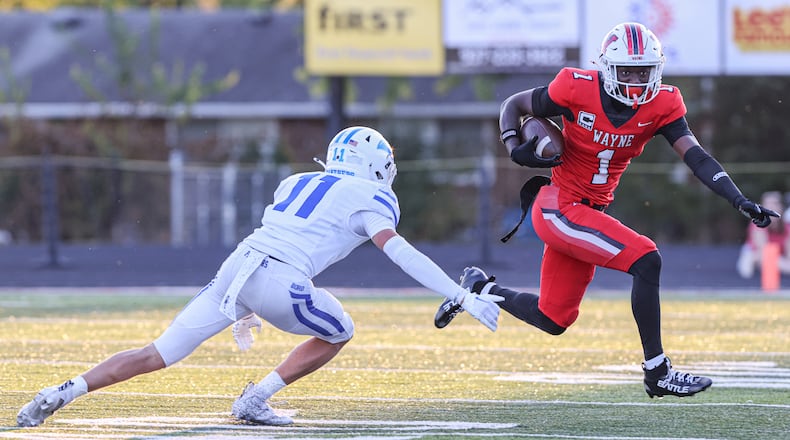The Dayton Daily News, Journal-News and Springfield News-Sun interviewed athletic directors across the region and found none who oppose the change. This is notable because a similar proposal failed by a two-to-one margin just three years ago.
Forcing the issue now is a lawsuit against OHSAA by the family of Jamier Brown, a junior who plays football at Wayne High School and reportedly missed out on deals, such as trading card licensing, ranging into six-figures because of Ohio’s current NIL rules.
Credit: David Jablonski
Credit: David Jablonski
“OHSAA’s blanket ban not only singles out Ohio’s high school student-athletes for unequal treatment, but it also unlawfully suppresses their economic liberty, freedom of expression, and restrains competition in the NIL marketplace,” the lawsuit says.
Local coaches say they don’t expect the change to cause a sea change in high school sports like paying athletes has caused in college sports — spurring bidding wars among well-funded programs to attract elite players and drawing resources from lower-profile sports.
For one, there aren’t that many Jamier Browns. Only a handful of high schoolers across the state are likely to draw any significant money, coaches say. High school students just don’t have that level of name recognition.
Proposed rules also play a factor, such as prohibitions on the use of school names or logos. If the local pizza joint wants to pay a student-athlete to appear in an ad, for example, the kid could appear in a blank jersey and say their name, but not what school they go to or team they play on.
Some local coaches see it as an issue of basic fairness.
“I’m a firm believer in capitalism,” said Middletown football coach Kali Jones. “If a 16-year-old can go get a job at a Wal-Mart, a Target, a Kroger, they can go get the job and they can earn money.
“There’s all of this hoopla because it’s based around sports. To tell a teenager or a young person who is eligible to work, who can benefit off of their image in the entertainment world that they can’t benefit in the athletic world, to me, is un-American.”
Driving the change
Ohio is one of six states that currently does not allow NIL deals for high school athletes. The others are Alabama, Indiana, Michigan, Mississippi and Wyoming. Several states approved NIL measures in 2020, and it first went into effect in Florida in 2021.
Luke Fedlam, a sports attorney from Amundsen Davis Law in Columbus, filed the lawsuit against the OHSAA on Oct. 15 on behalf of Jasmine Brown, the mother of Jamier Brown, who has verbally committed to play at Ohio State. In the suit, it is claimed Jamier Brown has missed out on opportunities ranging in dollar amounts up to six-figures.
A Franklin County judge issued a temporary restraining order against the OHSAA on Oct. 20 that, lasting 45 days, allows all Ohio high school athletes to currently have NIL rights. The OHSAA planned to put new NIL language up for a vote in May 2026, but decided to move it to this month after the TRO was issued.
A similar vote was held in 2022 that could have allowed Ohio student-athletes to profit off of their NIL. It was voted down by OHSAA member schools by more than a two-to-one margin.
“Spring of 2022 is very different than where we are in Fall of 2025 as it relates to people’s level of comfort with name, image, and likeness,” Fedlam said.
How it would work
The OHSAA Board of Directors approved proposed NIL bylaw language in September.
If passed, student-athletes would be able to enter into name, image, and likeness agreements through public appearances, social media promotion, licensing agreements and other avenues of providing public endorsements or recognition. Athletes agreeing to NIL deals would be allowed to be compensated. Reporting procedures and limitations would be established to allow student-athletes to remain eligible as amateurs to participate in OHSAA-sponsored sports.
Unlike at the college level, students would not be able to enter agreements with third-party collectives, or other booster clubs or foundations. NIL deals couldn’t be used as recruiting measures to attend a particular school.
Like at the college level, NIL deals would not be able to interfere with “official team activities,” which puts pressure on coaches and athletic directors to police.
An example of this would be athletes wearing shirts displaying branding at a team practice or on a bus ride to a game, which may not be always visible to the general public, but would not be allowed and would need to be reported as violations interfering with “official team activities”.
Questions remain on how that and all the proposed bylaws would be enforced in Ohio if passed.
Since most of the NIL attention will go to student-athletes who are prospects to be standout college athletes, Northeastern High School athletic director and football coach Jake Buchholtz would prefer if compensation were handled at the university level.
“If Wright State has a volleyball girl and they say, ‘Hey, we will pay you $50,000 to make sure you’re committed here’ then Wright State gets to deal with it and I don’t have to worry about it,” Buchholtz said. “But what’s going to stop that kid from going down to the local car dealership signing some autographs? Is that a breach of OHSAA bylaws? Is that an investigation? Those are things that I really do not want to mess with.”
Was process rushed?
Scott Grant, founder and chief impact officer for Triple Threat Leadership, has assisted high school athletic organizations in several states with the language used in their NIL policies.
He said the OHSAA seems to be rushing its NIL creation after having three-plus years since the first vote.
“If you don’t write a policy that is clear, consistent and enforceable, you’re going to have some issues,” he said.
Credit: David Jablonski
Credit: David Jablonski
For example, the proposed bylaws prohibit students from entering into contracts with schools or school employees, but doesn’t appear to prohibit coaches from helping student-athletes solicit or monetize NIL deals.
Grant also notes the proposal also requires student-athletes to report NIL deals to the school and state. But it’s unclear how much time they have to report them.
A hearing on the TRO injunction is scheduled for Dec. 15. If OHSAA schools turn down the referendum, the hearing would potentially allow the court to have input on any NIL language details.
“From my perspective, I would wait to see what happens and then work with your membership to develop language that is safe and compliant for everyone involved,” Grant said."
Swag instead of cash?
It is likely that all student-athletes under the age of 18 will need their parent or guardian to provide consent for them to enter into binding contracts.
There are tax implications for both parties entering into NIL agreements. The college sports commission requires all high school juniors and seniors to report all NIL deals of at least $600 in value in order to compete at the NCAA Division I level.
How many athletes will actually profit off of NIL remains unknown. Merchandising, such as clothing, and other items being received in place of cash payments will be a viable option that many more athletes could reasonably end up getting, according to Grant.
Fedlam said it’s where opinions on high school and college-type of NIL should differ. He said NIL in Ohio could be an opportunity for local communities to create energy and momentum for themselves.
“People get caught up when they hear NIL of simply thinking of these multi-million dollar deals,” Fedlam said. “But name, image, and likeness is simply the licensing of someone’s name to a third party for a fee.
“If I were to have a softball player, a women’s volleyball player, a basketball player promoting my business to their followers, there could be opportunity for that to be valuable to the business.”
Will it pass?
Grant said Ohio is the only state to have previously voted down NIL to have not passed it since.
This year a push was needed to change bylaws, according to Fedlam, and Jamier Brown had a significant opportunity to help other student-athletes in the process.
Credit: Nick Graham
Credit: Nick Graham
The challenge, said Buchholtz, is approving it to allow the OHSAA to write the rules on NIL.
“We’re looking at it now as it’s going to happen,” he said. “We all saw how it worked in NCAA. They fought it, fought it, fought it and then it was like the flood gates got opened and now you’re trying to go back (with regulations). Obviously, we’re a small school. I don’t know if we’re really going to be impacted by it.”
Whether that means OHSAA members will pass the referendum is to be determined. Any size school would be able to have student-athletes annually entering into deals if it is approved. NIL then could be presented as a chance to gain early-life financial literacy and responsibility.
“It’s a great opportunity. It’s a conduit to teach young people valuable life skills through name, image, and likeness,” Fedlam said.
About the Author






